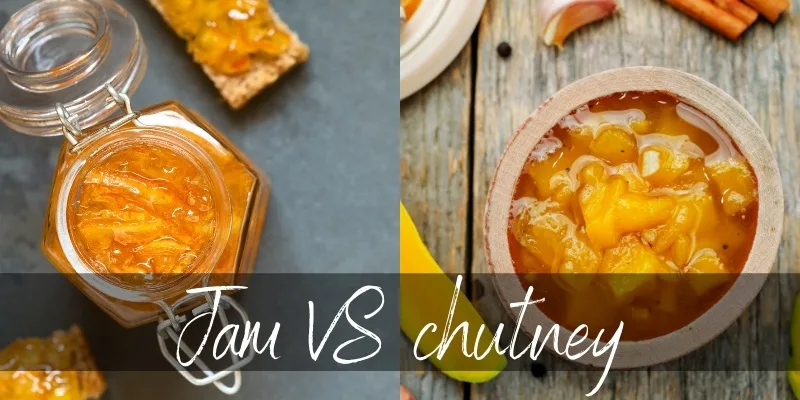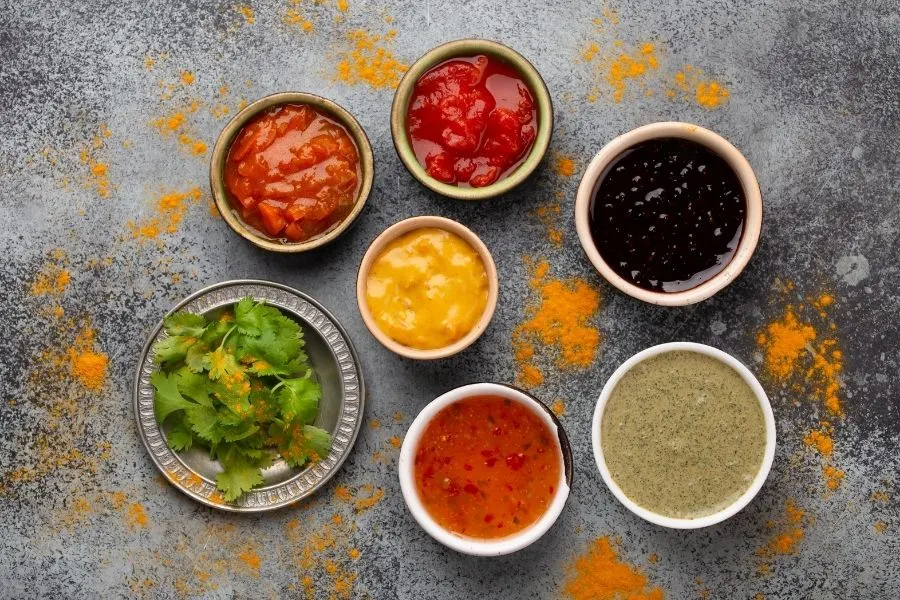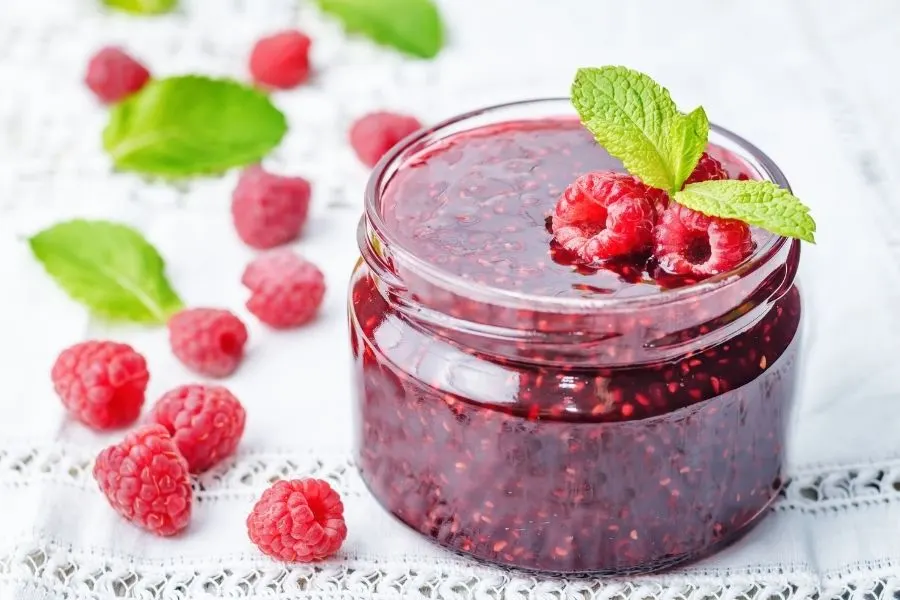Jam and chutney sound very different and in truth they have some clear differences. But what are those differences, really ? When you look at a jar of each you can’t really tell them apart. Often the ingredients on the label don’t offer much help either.
So how is jam different from chutney ? And can you use one in place of the other ?

Jam vs chutney
Jam is a fruit preparation that’s always sweet and generally meant as a dessert, while chutney may contain fruit and/or vegetables, and is meant more as a savory-sweet addition to a meal.
Chutney may encompass several sauces and jam-like preparations in Indian cuisine, but in Western culture it’s almost always fruit-based and contains vinegar and spices that bring it into savory territory.
Jams are meant for long term storage, as a way of keeping fruit from one year to another. Chutney is a way of incorporation fruit or vegetables into savory dishes, and is consumed within a few days.
Read also: Best Mango Chutney Substitutes
In short, the only thing chutney and jam have in common is that they both have fruit, and may be sweet. But after that, the rest of the spices and flavors used in chutney and how each is used varies wildly. Let’s explore these differences in detail in the following sections.
1. Chutney is a wide term used for many Indian sauces
Let’s clear up what chutney is (or can be), because it a very flexible definition. Chutney is an Indian word that can mean a number of sauces and dips that are fruit and/or vegetable based. They’re often sweetened, pickled, have vinegar added, and contain any number of spices. Think of chutney as a savory-sweet sauce or dip that can be almost anything, and may sometimes look like a jam.

For example that delicious mint sauce you sometime get with Indian takeout ? Chutney. Sweet and sour mango spread ? Chutney. The most common chutney in the Western world is the fruit-based ones.
Those are fruit, sugar (less than jam), vinegar, and various spices that are common in Indian cuisine like fenugreek, cumin, ginger, coriander, tamarind, onion, coconut, lime, chili, garlic, and so on.
By comparison jams are much simpler and refers only to fruit preserves that are meant for dessert, and are fairly thick but not as much as marmalade. Jam always has fruit in it, usually chopped or mashed.
2. Jam is sweeter than chutney
Both mango and chutney are sweet, but they diverge once you add vinegar. We’re going to talk mostly about the Western style chutneys, but will also touch on the various savory chutneys.
Jam is equal parts sugar and fruit. Western style chutney is sugar and fruit, but with less sugar, and with vinegar added. When you take into account the wide variety of Indian chutneys, you notice that a good number of them are completely savory and not sweet at all.
3. Chutney has many spices and flavors
Possibly the biggest difference between jam and chutney is the use of spices. Some jams may use a bit of spice, like star anise or clove in an orange marmalade, but that’s about it. Normally jam is just the flavor of the fruit, or two fruits.
Chutney has a wild mix of many spices and seasonings that make up a complex flavor profile. For example a popular chutney is the coconut one, and each region on India has its own way of preparing it. So a recipe could include fresh coconut flesh (or dried coconut), garlic, cumin, ginger, coriander, chili, and black pepper, all blended or ground together and mixed with hot water. A bit of sesame seed oil or peanut oil will always help.
4. Jam is a dessert, chutney is meant for savory dishes
If you’re staring at two jars of very similar-looking fruit preserves, one says chutney and the other jam, think of this. Jam is always meant as a dessert, or a sweet treat. Even if you want to add the jam to a roast meat, it’d be too sweet.

Chutney is supposed to go with savory foods, so it’s not as sweet as jam and may also have a wide range of other flavors in there. For example it could be apricot jam and apricot chutney.
The jam would taste of apricot and that’s that. The chutney would possibly have apricot, vinegar, onion, cumin, coriander, a dash of cinnamon, chili, and some coconut as well. It’d be sweet, but not as sweet as a jam and definitely not a dessert.
Oh, also take a good look at the two jars. Chutney will have various textures and colors, but it will almost always have flecks of spices throughout it, while jam does not.
5. Chutney can be veggie-based, jams is always fruit-based
As jam relies on pectin to set and to store it for a long time, it needs pectin, which is highest in fruit. Chutney is meant to be consumed immediately or in a couple of days, so pectin is important only to bring everything together (where applicable).
So you will easily find chutneys with an vegetable base like onion, tomato, bell pepper or chili, cucumber, spinach with various additions. It could be cooked or raw, and it may also contain dairy. Chutney is a wide definition.
6. Jams last much longer than chutneys
If you’re looking to get a long-lasting jar, know that chutneys are not built to last as long as jams. Even if you buy Western style chutneys that resembles jams, they won’t hold as long as a jam.
The pectin content is generally lower, and they usually have a shorter shelf life. Granted, many of them have preservatives as does pretty much everything on a store shelf. But traditionally, chutneys are meant to be consumed within a few days.
Jams are supposed to last you all throughout winter, maybe even two winters if you have enough jars.
Read Also: Why Is My Jam Not Setting ?
Can you turn jam into chutney ?
You can turn jams into chutneys if you add several spices, a dash of vinegar, and add more fruit and/or vegetables. Otherwise the chutney will be too sweet and it won’t cross into savory territory.
So let’s say you have a mango jam. Keep in mind that chutneys do have fruit but they’re usually just a few fruits like mango or peach or apricot. Take the mango jam and pour it into a saucepan, use less than you need because we’re going to bulk it up.
Get fresh mango or decide on a fruit that goes well, like apricot, peach, pineapple, papaya, something similar. Chop the fresh fruit, add it to the saucepan, and add any spices you like. A few spices that go with this recipe are cumin, coriander seeds, parsley leaves, sauteed onion, grated garlic, and chili flakes. Add a dash of vinegar and bring everything to a simmer for a few minutes.
Turn the heat off, and transfer to a serving dish. The result should be a little sweet, but not as sweet as the original jam. It might sound like an odd mix, but chutneys are an interesting blend of sweet and savory that can really turn any dish around. They may contain vegetables and fruits and spices mixed in ways you wouldn’t normally think to use them.

